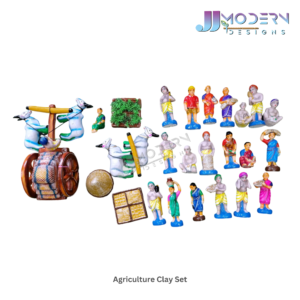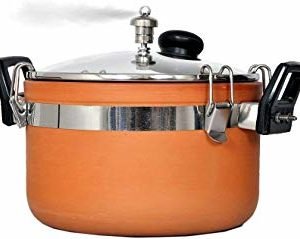Agriculture Set 7inch(Clay)
₹ 7,500.00 ₹ 6,800.00
The “Agriculture Clay Set” by JJModern Designs sounds fascinating! With 31 doll pieces, it seems comprehensive in portraying various aspects of agriculture. From what you’ve described, it covers essential elements such as cultivating rice and wheat, air plowing, and spraying pesticides, offering a holistic representation of the agricultural process. This set could be educational and entertaining, providing insights into the intricate steps involved in farming while also allowing for imaginative play.
Agriculture Set
About this Item
-
Theme Religious
-
Brand JJ Modern Designs
-
Style Traditional
-
Material Clay
-
Occasion Navaratri
-
Product Dimensions in inches 7inch
-
No.of.dolls 31pieces
-
Weight 10.900 KG
The “Agriculture Clay Set” made by JJModern Designs sounds like an engaging and educational product. It can also be set in golupadi. Clay is a versatile material known for its malleability, making it ideal for crafting detailed miniature representations of various agricultural elements. Here’s how such a set could be structured:
1. Clay Doll Pieces: These are the main components of the set, representing different aspects of agriculture. Each piece could depict elements such as farmers, animals, crops, machinery, and tools.
2. Rice and Wheat Fields: Miniature fields made of clay could represent the cultivation of rice and wheat, complete with tiny plants at different growth stages.
3. Air Plowing Model: A clay model of an aircraft or drone could depict air plowing, showcasing modern agricultural practices for land preparation.
4. Spraying Pesticides: Another clay model might represent the process of spraying pesticides on crops, with a miniature sprayer or drone releasing tiny droplets onto the fields.
5. Agricultural Machinery: Clay models of tractors, harvesters, and other farming equipment could be included to illustrate mechanized farming methods.
6. Farmers and Animals: Clay figurines of farmers tending to their fields and livestock, along with miniature animals like cows, sheep, and chickens, could add realism to the set.
7. Accessories and Props: Various accessories such as fences, barns, water tanks, and irrigation systems could enhance the play experience and provide context for different agricultural activities.
About Agriculture Process
Certainly! The agriculture process involves a series of steps aimed at cultivating crops and raising livestock. Here’s a generalized overview:
1. Land Preparation: This involves clearing the land of any debris, rocks, or unwanted vegetation. It may also include plowing, which breaks up the soil to prepare it for planting.
2. Planting: Seeds or seedlings are sown or planted in the prepared soil. Different crops have different planting requirements, including spacing, depth, and timing.
3. Watering/Irrigation: Depending on the climate and soil moisture, crops may need to be watered regularly. Irrigation systems such as sprinklers, drip irrigation, or canals may be used to ensure proper hydration.
4. Fertilization: Nutrients are essential for plant growth. Fertilizers containing nitrogen, phosphorus, and potassium, among other elements, are applied to the soil to replenish nutrients that may be lacking.
5. Weeding: Unwanted plants, or weeds, compete with crops for resources such as sunlight, water, and nutrients. Weeding involves removing these weeds to prevent them from negatively impacting crop growth.
6. Pest Control: Pests such as insects, rodents, and diseases can damage crops. Various methods are used to control pests, including chemical pesticides, biological controls, and cultural practices like crop rotation.
7. Harvesting: When crops reach maturity, they are harvested. This can involve cutting, picking, or uprooting the plants, depending on the crop type.
8. Post-Harvest Handling: After harvesting, crops may undergo additional processing, such as cleaning, sorting, and packaging, to prepare them for market.
9. Storage: Some crops are stored for later use or sale. Proper storage conditions, including temperature, humidity, and ventilation, are crucial to prevent spoilage.
10. Crop Rotation/Soil Management: To maintain soil fertility and prevent disease buildup, farmers may rotate crops or use cover crops to enrich the soil.
11. Livestock Care: In addition to crop farming, agriculture often involves raising livestock. This includes providing food, water, shelter, and medical care to ensure the health and well-being of the animals.
These steps represent a general overview of the agriculture process, though specific practices may vary depending on factors such as location, climate, and the type of crops or livestock being raised.The “Agriculture Clay Set” by JJModern Designs sounds fascinating! With 31 doll pieces, it seems comprehensive in portraying various aspects of agriculture
Related Products
- desktop-columns-3 tablet-columns-2 mobile-columns-1
-
Vitobha Krishna 1ft (Clay)
₹ 1,800.00₹ 1,500.00 -
-
-
-
Namakal Anjineyar clay 18inches
₹ 2,500.00₹ 2,200.00 -
-
-
-






















